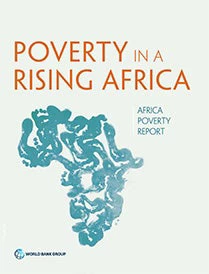
The consumer price index (CPI) is the most commonly used measure of inflation in the world, and Africa is no exception. But do CPIs reliably reflect the actual change in the cost of living? And if not, how does this affect our understanding of how poverty has evolved in the region?
The CPI is derived from a fixed and supposedly representative basket of goods and services provided in the domestic market to measure a cost-of-living index. To keep up with changing consumption patterns, the basket weights need to be updated regularly. But often they are not. Most get updated every decade or even less frequently, so they become less and less representative of the items that consumers actually purchase.
This issue is especially pronounced in Sub-Saharan Africa, partly linked to the infrequency of household budget surveys (from which basket weights are computed). For instance, in 2012, a mere 2% of the population in the region was living in countries in which the CPI baskets had been updated over the previous five years. Meanwhile, 13% of the population in the region was living in countries in which the baskets were based on data from the 1990s or even earlier.
In a recent background paper, “CPI bias and its implication for poverty in Sub-Saharan African countries.” for the Poverty in a Rising Africa report, we use the Engel curve method (see papers by Costa 2001 and Hamilton 2001) to estimate if, and by how much, CPIs mis-measure changes in the cost of living (CPI bias hereafter) in 16 African countries with comparable survey data. Our results suggest that, in fact, the official CPIs mostly overstated changes in the cost of living and therefore we may have underestimated the decline in poverty in the region.
The analysis is based on Engel’s law, one of the most well-known empirical regularities in economic data, which says that with rising real income households spend a declining share of their total budget on food. Absolute spending on food may still increase, as household income increases, but in relative terms, food expenditures decline. However, if we observe that over time households with the same level of real income (and similar demographics and relative prices) spend an increasingly smaller (or larger) share of their budget on food, this may, under certain assumptions, signal mismeasurement in the way nominal incomes are deflated into real values (that is, CPI bias).
To see this, consider Figure 1 which plots Engel curves for the Democratic Republic of Congo and Ethiopia (the estimations control for relative prices, household size and household composition). The solid curves—the reference curves—are for the older of the two surveys. The dotted curves are for the latest survey year. Over time, food budget shares among demographically similar households at the same level of real income should remain the same. In other words, if CPI-adjusted nominal household incomes reflect real household incomes, the Engel curves from different time periods should overlap, which is clearly not the case here. The fact that the curves from the latest surveys lie below the reference curves suggests that the CPIs may overstate the changes in the true cost of living in these countries. Households with the same food budget share seem to have less income than before.
Figure 1: Engel curves

Right: Ethiopia, 2004/05 –2010/11
In 13 out of 16 countries in our study, the estimated CPI bias is positive during the sample periods, which suggests that households allocated their budget on food as if their true cost of living was increasing more slowly than the rate indicated by the CPI. The average upward bias ranges from 0.7 percent a year in Cameroon to 30.5 percent a year in Tanzania.
What does this mean for poverty measurement? For illustration, we use the international poverty line of $1.90 per person per day in 2011 Purchasing Power Parity (PPPs) exchange rates. For the benchmark and comparison year, this poverty line is converted to local currencies using 2011 PPPs and local inflation, as measured by the official CPIs in these countries – as, for example, in PovcalNet. We then compare this rate of poverty reduction with an alternative series, where we update the poverty line between the base and comparison years according to the rate of inflation suggested by the Engel curve method. We would expect the bias-corrected poverty reduction to be larger than the reported poverty reduction in countries where the CPI overstates inflation, but the opposite in countries where the CPI understates inflation.
Figure 2 summarizes changes in poverty after correcting for CPI bias. We find that implied revisions can be large for some countries: the difference in annualized poverty reduction ranges from about +5 percentage points in Ghana to almost -6 percentage points in Tanzania. In most countries, CPI-adjustment understates poverty reduction (as indicated by a negative value in Figure 2) – though there are some few countries where the results go in the opposite direction, signaling that the use of the CPI overstates poverty reduction (a positive value in Figure 2).
Figure 2: Correcting for CPI bias suggests that poverty may have declined faster

How do we interpret these results? Of course, some words of caution are in order. The Engel curve method used here requires several assumptions, such as stable preferences, which we cannot test formally. Moreover, CPIs, by design, reflect inflation faced by households between the 70 th and 90 th percentiles of the income distribution. Our Engel curve estimates, on the other hand, are broadly representative of the urban population, because in all but four countries CPI data collection was geographically restricted and only urban households used for the estimation. Hence some of the measured gap in inflation may reflect differences in inflation at different points of the distribution. Research on more countries and time periods, and including rural areas, would be needed to draw a firm conclusion about CPI bias and how it affects poverty trends if Africa. But if these results can be confirmed they would signal good news: poverty in many African countries may have declined faster than we currently think.
Read previous blogs in the Poverty in a Rising Africa report series:
- Africa is rising! But are people better off?
- Who will fund poverty surveys in Volkswagen countries?
- The European refugee crisis: What we can learn from refugees in Sub-Saharan Africa
- Poverty is falling faster for female-headed households in Africa
- The shock of widowhood: Marital status and poverty within Africa
- Domestic Violence and Poverty in Africa: When a Husband’s Beating Stick is Like Butter
- Data gaps: The poor typical household survey’s miss
- Inequality of opportunity in Sub-Saharan Africa
- Is inequality in Africa rising?
- Education for all in a “rising Africa”
- When growth alone is not enough
- Yep, about reading and writing again
- A glimpse behind the curtain: CPIs in Africa
- Once poor, forever poor?




Join the Conversation